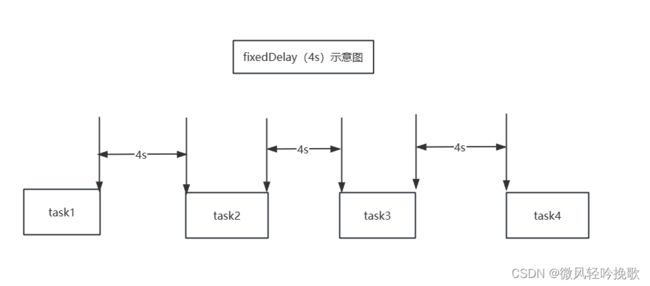Springboot定时任务 Spring task
文章目录
-
- Spring Task 简单操作
-
- SpringBoot注解开始
-
- 1.fixDelay
- 2.fixedRate单线程
- 3.fixedRate多线程
- 4.initialDelay
- 5.cron(推荐)
- 6.任务调度配置
Spring Task 简单操作
SpringBoot注解开始
@EnableScheduling
@SpringBootApplication
//开启spring task
@EnableScheduling
//开启多线程
@EnableAsync
public class SpringTaskApplication {
public static void main(String[] args) {
SpringApplication.run(SpringTaskApplication.class, args);
}
}
1.fixDelay
程序开始运行后,在上一个任务结束时 间隔 固定时间再次执行
@Scheduled(fixedDelay = 3000)
@Scheduled(fixedDelay = 3000)
//fixedDelay 上一个任务结束 等待 3s 则下一个任务开始
public void fixedDelay(){
log.info("这里是delayTask执行");
}
执行结果
2.fixedRate单线程
fixedRate 上一个任务开始,间隔3s下一个人任务开始
但是如果单线程操作则无法看到,需要配置为多线程
@Scheduled(fixedRate = 10000)
@Scheduled(fixedRate = 10000)
// fixedRate 上一个任务开始,间隔10s下一个任务开始
// 但是如果单线程操作则无法看到,需要调节至多线程
public void fixedRate(){
ThreadUtil.safeSleep(11000);
log.info("这里是fixedRateTask执行");
}
执行结果
3.fixedRate多线程
多线程须在在类上加上@EnableAsync 在方法上加上@Scheduled(fixedRate = 10000)
@Async 这样才能改为多线程
@Scheduled(fixedRate = 10000)
@Async
// fixedRate 上一个任务开始,间隔10s下一个任务开始
// 但是如果单线程操作则无法看到,需要调节至多线程
public void fixedRate(){
ThreadUtil.safeSleep(11000);
log.info("这里是fixedRateTask执行");
}
执行结果
4.initialDelay
第一次延迟多长时间后再执行 @Scheduled(initialDelay = 5000,fixedDelay = 2000)
@Scheduled(initialDelay = 5000,fixedDelay = 2000)
// initialDelay 第一个Task 5s后执行 其余2s
public void initialDelay(){
log.info("这里是initialDelayTask执行");
}
执行结果
5.cron(推荐)
该参数接收一个cron表达式,cron表达式是一个字符串,字符串以5或6个空格隔开,
分开共6或7个域,每一个域代表一个含义。**corn基本可以生成所有想用的周期**
(点击下方链接即可在线生成)@Scheduled(cron = "10/3 * * * * ? ")
在线生成cron
@Scheduled(cron = "10/3 * * * * ? ")
// cron 第一个Task 5s后执行 其余3s
public void cron(){
log.info("这里是corn执行");
}
6.任务调度配置
如果只是简单使用,不配置也能使用
# 任务调度线程池大小 默认 1 建议根据任务加大,工厂经理, 如果不开启异步,就是经理们亲自干活
spring.task.scheduling.pool.size=1
# 调度线程名称前缀 默认 scheduling-
spring.task.scheduling.thread-name-prefix=scheduling-
# 线程池关闭时等待所有任务完成
spring.task.scheduling.shutdown.await-termination=
# 调度线程关闭前最大等待时间,确保最后一定关闭
spring.task.scheduling.shutdown.await-termination-period=
# 任务执行线程池配置
# 是否允许核心线程超时
spring.task.execution.pool.allow-core-thread-timeout=true
# 核心线程池大小 默认 8
spring.task.execution.pool.core-size=8
# 线程空闲等待时间 默认 60s
spring.task.execution.pool.keep-alive=60s
# 线程池最大数 根据任务定制
spring.task.execution.pool.max-size=10
马上中秋节









